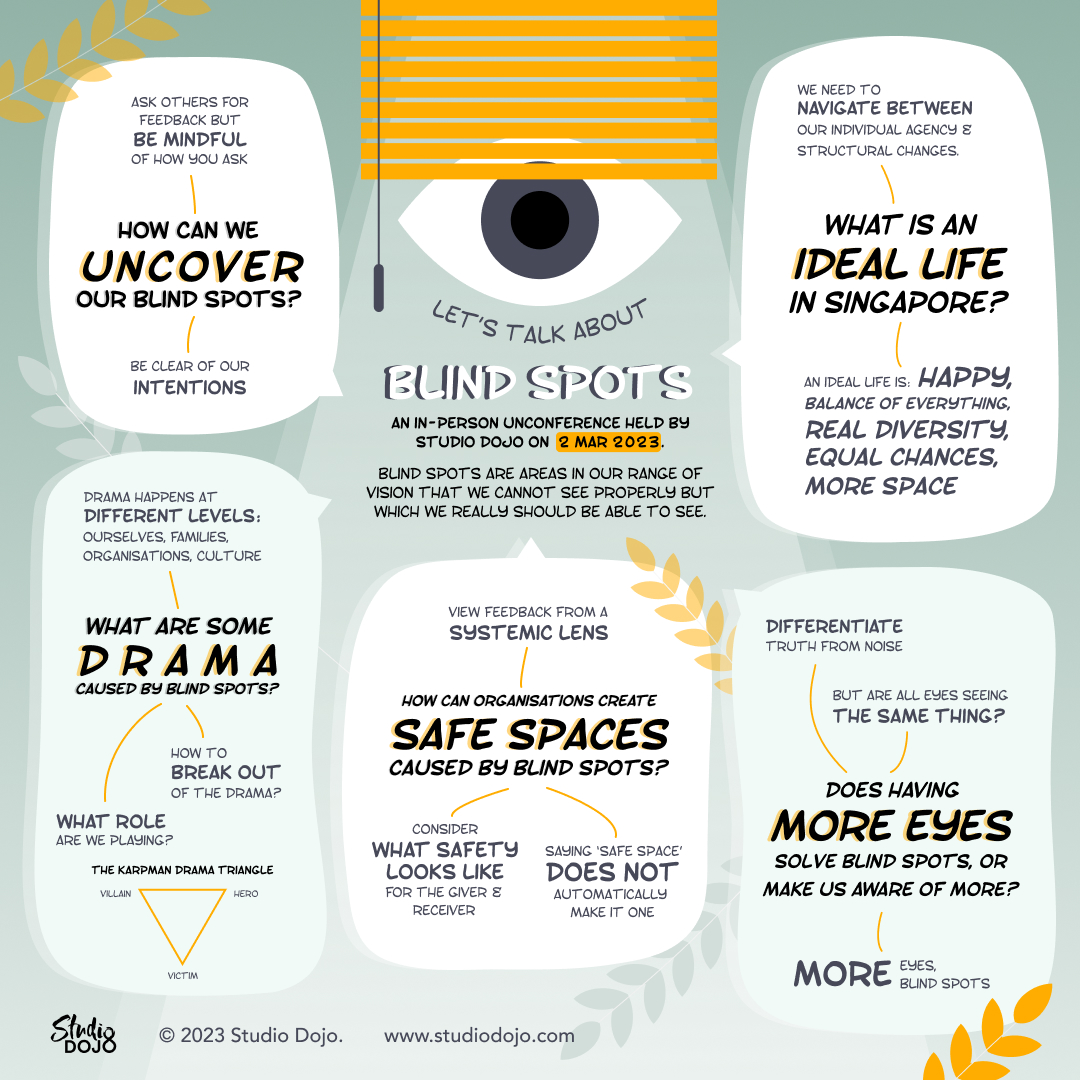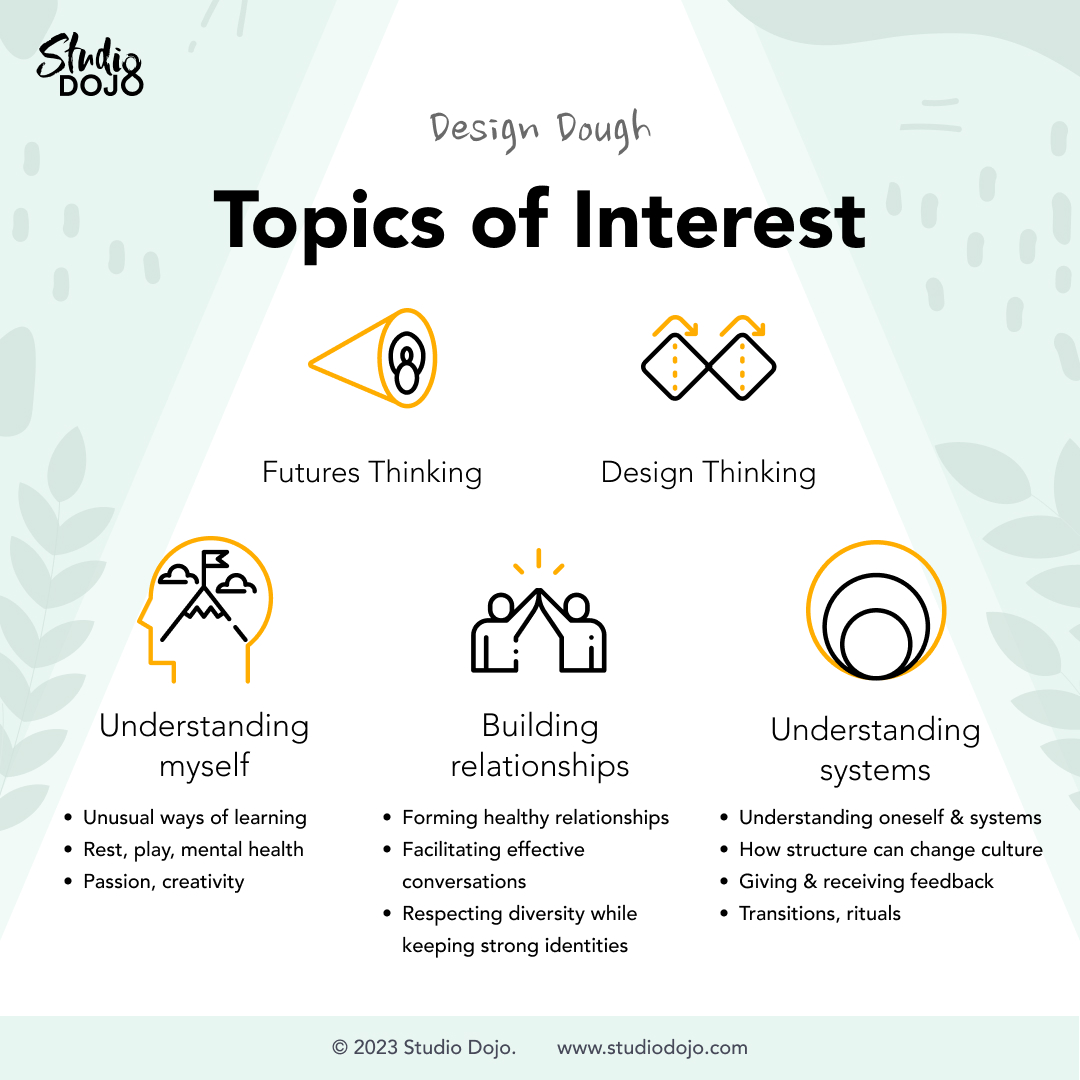Design Dough: Let’s Talk about Blind Spots
A blind spot is an area in our range of vision that we cannot see properly but which we really should be able to see. Imagine sitting in the driver’s seat in a car, the areas of the road that our rearview and side-view mirrors do not show – those are our blind spots. If we are not aware of them, it would affect our judgements and may cause an accident.
A similar phenomenon happens in our minds. The irony of a blind spot is that we can’t be expected to know what we can’t see. Yet, it is important for us to identify them as those are areas where our greatest potential for growth lies.
On 2nd March 2023, over 50 folks from our community gathered to discuss and explore this theme of blind spots. Designers, changemakers, students, teachers, coaches and even an acupuncturist! There was a great diversity of jobs, age and interests in the room. Led by Khai Seng and PJ, the group set foot in an unconference where participants exercised our own agency and set the agenda for the evening. Leaning into the range of curiosities in the room, the group came up with a whopping 55 topics that they would like to discuss. While some may seemingly be off-topic, we honoured the group’s agency in laying out all the possibilities. Amongst which, the group then voted for 5 topics and explored these topics:
- How can we uncover our blind spots?
- What are some drama caused by blind spots?
- How can organisations create safe spaces for us to give feedback?
- Does having more eyes solve blind spots, or make us aware of more?
- What is an ideal life in Singapore?
In the spirit of individual autonomy, the group also practiced the Law of Two Feet. If participants found themselves in a situation where they are not contributing or learning, they could simply move to another discussion.
Here are some key highlights from each discussion.
Topic 1: How can we uncover our blind spots?
Ask others for feedback but be mindful of how you ask.
- Create closeness with them so that they are comfortable to share. Consider how they are feeling before asking.
- Timing matters. Ask at the end of projects so that others have a clearer, fresh and more whole memory of interacting with you.
Prepare yourself before asking.
- Be clear and state your intentions to yourself before asking others. Johari Window model <link> is a good way to approach blind spots.
- Understand that there are different categories of feedback – emotional, work, behaviour.
Topic 2: What are some drama caused by blind spots?
Drama happens at different levels – within ourselves, our families, our organisation, our culture.
What role(s) are we playing in the drama?
- Karpman’s Drama Triangle shows that in every drama, there is always a Hero, a Villain and a Victim (Here’s a video explaining the drama triangle, if you prefer).
- Question: Are we playing these roles because of our needs or our wants?
How to break out of the drama?
- Reparent yourself, unlearn trauma.
- Look into Holistic psychology that examines a person as a whole. It considers the socio-economic influences that may have shaped the person.
- Question: Sometimes, is drama necessary for change?
Topic 3: How can organisations create safe spaces for us to give feedback?
Consider what safety looks like for the giver and receiver of feedback.
- Sometimes, they may differ.
- The 4 Levels of Psychological Safety is a good framework to consider what safety may look like for you.
- Question: Is psychological safety always necessary for us to give/receive feedback well?
Saying ‘safe space’ does not automatically make it one.
- Creating safety requires effort beyond simply declaring it as one.
View feedback from a systemic lens.
- Adopting a systemic lens, and looking beyond ourselves, may help limit the unpleasant stories we create when receiving feedback.
Topic 4: Does having more eyes solve blind spots, or make us aware of more?
More eyes, more blind spots.
- The more feedback we receive, the more we can see, and the more blind spots we grow to be aware of.
But are all the eyes seeing the same thing?
- While larger amount of feedback may help give more awareness, it depends if the people giving feedback have the same perspective, which may possibly bring groupthink, another form of blind spot.
Hone skill to differentiate truth from noise.
Topic 5: What is an ideal life in Singapore?
An ideal life in Singapore may look like this: happy, balance of everything, real diversity, equal chances, more space.
In imagining an ideal life, we navigate between the individual agency and structural changes.
- While we may have full control of our agency (our intent, mindset and actions), we also have to consider structural limits (e.g. environments we are in) that we may not have full control over.
Question: Is a holistic life an ideal life?
At the end of the evening, the group left with some learnings, more questions, and a great keenness for future sessions. The group gave a 9 out of 10 average rating to come back for another Design Dough series, in the feedback form. Here are some topics that the community is interested to explore in future sessions.
Till we gather again in the next Design Dough, let’s continue the work of discovering our blind spots lest we get blindsided by them 👀





